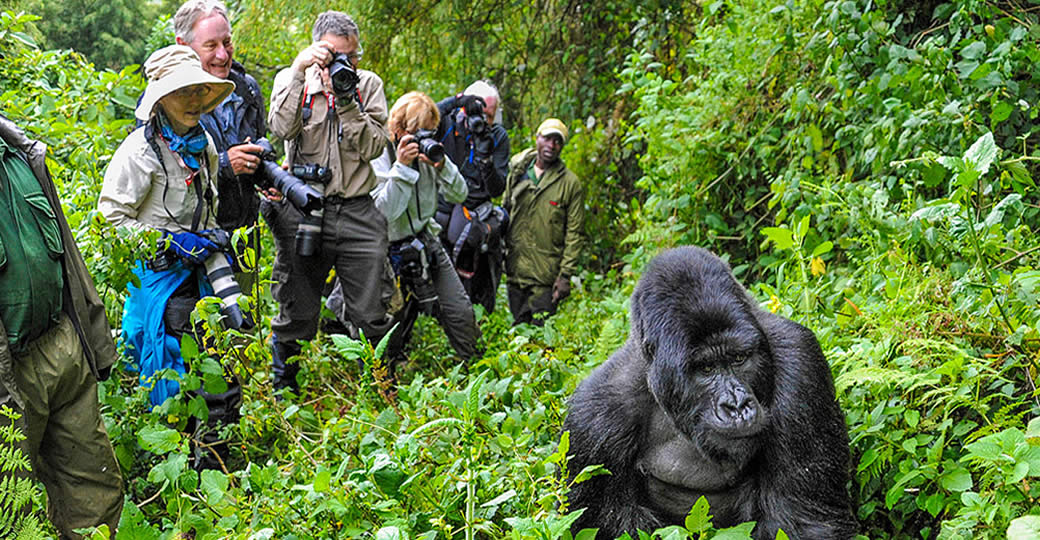Gorilla trekking is of no doubt an extra-ordinary wildlife experience attracting thousands of tourists each year who come to get up-close with the endangered mountain gorillas. But what leaves many still wondering or asking themselves is what are the chances of seeing mountain gorillas in the wild? What is a success rate to find a habituated gorilla group in their natural habitat? Considering the cost for gorilla trekking, many get concerned about the chance of seeing these rare apes in the wild.

But what is significant to take note of is that the chances of seeing mountain gorillas in Uganda or Rwanda are higher. Based on our experience on gorilla safaris, we can confidently say that gorilla trekking success rate to find habituated mountain gorilla groups in their natural habitat in Uganda and Rwanda is about 99%. There are many measures that have been put in place to ensure tourists can easily find these dramatic creatures.
Firstly, there is advance team or gorilla trackers who always sent to locate or monitor the movement of these rare creatures before a group of trekkers begin their gorilla trek. The trackers ensure they are in touch with park guide and this has increased visitor chances to find or see mountain gorillas in the wild.
Secondly, a lot has been done on gorilla conservation and protection. Due to continued commitment to protect these rare apes, their population has kept on increasing thus increasing higher chances of visitors to see a gorilla or gorillas. Currently, the world boasts of an estimate of 1063 mountain gorillas, 459 of these are within Uganda’s Bwindi Impenetrable National Park with 24 habituated gorilla families available for gorilla trekking. In Rwanda, visitors trek the 12 habituated gorilla family groups and as you head to DR Congo’s Virunga National Park, expect to explore 8 habituated gorilla families.
Mountain gorilla trekking safari destinations in Africa.
Mountain gorilla treks in Africa are offered only in Bwindi Impenetrable National Park and Mgahinga Gorilla National Park in Southwestern Uganda; Volcanoes National Park in Northwestern Rwanda then the Virunga National Park in Eastern DR Congo. When planning for a successful gorilla trekking trip, there is a lot to put together ranging from purchasing a gorilla permit, securing your airline tickets, transport to and fro, visas, accommodation, equipment to mention but a few.
Why the gorilla trekking success rate is high?
- Mountain gorilla groups in Uganda, Rwanda are assigned while considering visitors’ level of fitness. If you are fit enough then you can trek the farther away gorilla families and the elderly can be allocated to the nearby gorilla family groups. The idea behind all this is to ensure all trekkers make a complete gorilla trek. Therefore, let the park ranger guide or park official know your physical fitness level before being assigned to a gorilla group. Note, being young may not mean that you are very fit or healthy.
- Advanced team is sent to monitor the location of gorilla families and it is responsibility of that team to communicate back to park guide earlier before leaving the park offices with trekkers. They do so with aid of Global Positioning System, Satellite phones/radios. Before, finding gorillas was challenging but this has been made easier.
- Book your gorilla safari in advance at least 4-5 months before the actual date of gorilla trekking. This can increase your gorilla trekking success rate in Uganda or Rwanda. Reserving your gorilla safari especially during the high or peak season (June-September or December-February) is significant since this is a period when gorilla safari parks record the highest number of visitors.
- Booking a gorilla safari and permit late may not guarantee you a gorilla permit. Once you book your gorilla permit early, ensure you request for an easier to trek gorilla family. Gorilla permits in Uganda cost $800, Rwanda $1500 and DRC $450 per person.
- All gorilla treks in Uganda, Rwanda and DRC are carried out only in already habituated gorilla group families. This means that these are already used to human presence and usually, they won’t walk away when visitors approach them but note, don’t touch them, keep a distance of at least 7-10 meters away from them.
